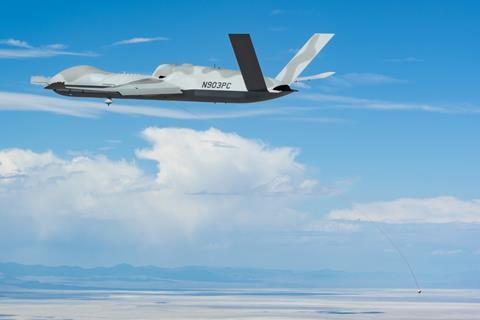San Diego-based aircraft producer General Atomics Aeronautical Systems is testing a method for recovering small uncrewed aerial systems (UAS) while in flight.
General Atomics is developing the tow line system in partnership with Breeze-Eastern, a helicopter winch manufacturer in New Jersey. The concept, which is called the Aerial Recovery System (ARS), envisions deploying a tow cable from a large category UAS to capture smaller craft.

General Atomics on 10 October revealed that it conducted an ARS demonstration flight on 20 September at Dugway Proving Ground in Utah. The test involved a General Atomics MQ-20 Avenger UAV outfitted with a Breeze-Eastern commercial hoist.
The hoist cable was modified with a “smart end feature” developed by General Atomics and integrated into the MQ-20’s payload bay.
“While in flight, the tow line was deployed away from Avenger to the optimal distance for aerial recovery,” General Atomics says. “The smart end feature was able to wirelessly transmit its position back to Avenger, confirming its ability to transmit the data to a nearby SUAS for aerial recovery.”
Once a SUAS has been secured on the tow line, the craft’s wings fold and its engine cuts off, transitioning it into a “passively stable towed body”, General Atomics says.
The two UAS would then return to base together, the company notes, for refuelling, recharging or rearmament.
Mike Atwood, General Atomics’ vice-president of advanced programmes, says the ARS concept is now possible “thanks to advances in relative navigation technology, complex tow line analysis, and multi-aircraft control” his company has pursued.
In addition to recovering SUAS, General Atomics says the ARS would allow the larger “mothership” vehicle to re-deploy smaller craft back into combat.
“Aerial re-deployment allows UAS like Avenger or [General Atomics] MQ-9A Reaper to serve as mobile command centres for a network of SUAS,” General Atomics says.
Such a capability could support a large network of SUAS for missions including surveillance, electronic attack, suppression of enemy air defences, communication relays and mobile command and control, the company notes.
The concept could allow more expensive and less numerous UAS to remain farther from enemy defences, while deploying a wave of smaller, cheaper systems into harm’s way.
The US Army is currently developing a concept for SUAS, which the service calls air-launched effects (ALE).
Such platforms would be fired from army helicopters – such as the next-generation Future Attack Reconnaissance Aircraft (FARA) – and used to support ground troops with reconnaissance and kinetic strike capability.
ALE vehicles could also serve as pilotless wingmen to crewed aircraft in hostile airspace.
A single FARA helicopter will eventually carry up to eight ALE vehicles, according to the army, all of which will be able to collaborate semi-autonomously to complete assigned missions, a concept the service calls “wolf pack”.
While the army envisions small ALEs as low-cost, expendable platforms, the service is also exploring a larger ALE category that would carry more powerful sensors of payloads and be reusable – potentially through ARS.
General Atomics is currently developing a large ALE that it calls the Eaglet.
In testing, the experimental design is launched from a large General Atomics MQ-1C Gray Eagle multi-role UAS, although the company envisions launching the Eaglet from rotary aircraft and ground vehicles.


























